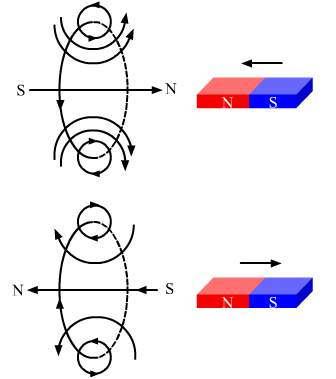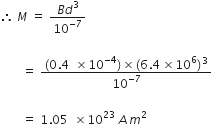 Short Answer Type
Short Answer TypeDraw a graph to show variation of capacitive-reactance with frequency in an a.c. circuit.
The field lines of a negative point charge are as shown in the figure. Does the kinetic energy of a small negative charge increase or decrease in going from B to A? 
In a meter bridge shown in the figure, the balance point is found to be 40 cm from end A. If a resistance of 10 is connected in series with R, balance point is obtained 60 cm from A. Calculate the values of R and S. 
A series LCR circuit is connected across an a.c. source of variable angular frequency ‘ ’. Plot a graph showing variation of current 'i' as a function of ‘’ for two resistances R1 and R2 (R1 > R2).
’. Plot a graph showing variation of current 'i' as a function of ‘’ for two resistances R1 and R2 (R1 > R2).
Answer the following questions using this graph:
(a) In which case is the resonance sharper and why?
(b) In which case in the power dissipation more and why?State Lenz's law. Illustrate, by giving an example, how this law helps in predicting the direction of the current in a loop in the presence of a changing magnetic flux.
In a given coil of self-inductance of 5 mH, current changes from 4 A to 1 A in 30 ms. Calculate the emf induced in the coil.
OR
In what way is Gauss's law in magnetism different from that used in electrostatics? Explain briefly.
The Earth's magnetic field at the Equator is approximately 0.4 G. Estimate the Earth's magnetic dipole moment. Given: Radius of the Earth = 6400 km.
Lenz law states that,polarity of the induced emf is such that it opposes a change in magnetic flux.
The given activity demonstrates the above statement. The amount of magnetic flux linked with the coil increases, when the north pole of a bar magnet is brought near the coil. Current in the coil is induced in a so as to opposes the increase in magnetic flux. This is possible only when the current induced in the coil is in anti-clockwise direction, with respect to an observer. The magnetic moment associated with this induced emf has north polarity, towards the north pole of the approaching bar magnet.
Similarly, magnetic flux linked with the coil decreases when the north pole of the bar magnet is moved away from the coil. Inorder to oppose this decrease in magnetic flux, current is induced in the coil in clockwise direction so that its south pole faces the receding north pole of the bar magnet. This would result in an attractive force which opposes the motion of the magnet and the corresponding decrease in magnetic flux.
Given,
Self-inductance, L = 5 mH = 510-3 H
Change in current, dI = (4-1) = 3 A
Change in time, dt = 30 ms = 3010-3 s
So, emf induced in the coil is given by, 
OR
i) Gauss’s law for magnetism states that magnetic flux through any closed surface is 0.
That is,

Gauss law for electrostatics states that electric flux through a closed surface is give n by,

Therefore, electric flux is zero when the surface encloses an electric dipole.
Magnetic flux is zero implies that, isolated magnetic poles do not exist.
ii) Given,
Magnetic field of Earth = 0.4 G = 0.4 10-4 G
Equatorial magnetic field of earth is given by, 
where, d = 6400km = 6.4 x 106 m
Therefore, Earth’s magnetic dipole moment is given by, 
How are electromagnetic waves produced? What is the source of energy of these waves? Draw a schematic sketch of the electromagnetic waves propagating along the + x-axis.
Indicate the directions of the electric and magnetic fields. Write the relation between the velocity of propagation and the magnitudes of electric and magnetic fields.Find the equivalent capacitance of the network shown in the figure, when each capacitor is of 1 ![]() F. When the ends X and Y are connected to a 6 V battery, find out
F. When the ends X and Y are connected to a 6 V battery, find out
(i) the charge and
(ii) the energy stored in the network
State the underlying principle of a potentiometer. Write two factors by which current sensitivity of a potentiometer can be increased. Why is a potentiometer preferred over a voltmeter for measuring the emf of a cell?
